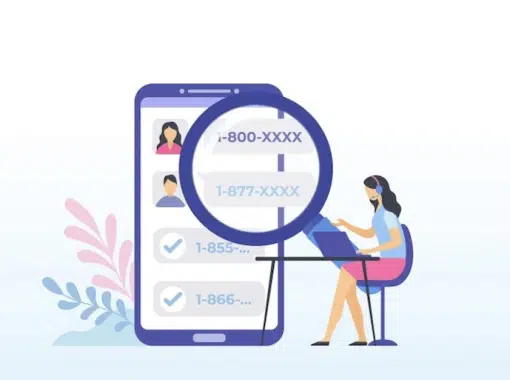Inbound Marketing and Call Tracking: How to Track Leads Throughout the Sales Cycle
Like a sports team with a star player, a business can excel with one strong department. If marketing or sales drives big business and everyone else meets expectations, you can have a steady profit.
Rely on a star player who gets hurt, however, and everyone suffers. Your team cannot compensate. In sports as in business, it’s advantageous to have a well-rounded base of success where individuals and departments are all performing well. Fortunately, lead tracking makes this possible.
If sales are good now, systemized lead tracking throughout the sales cycle will make them better. Find weak spots in the sales process and strengthen them.
Lead tracking allows you to measure the true return on investment (ROI) on your efforts. It integrates seamlessly with your business 800 number. When you combine inbound marketing with call tracking, you can discover what works and target your areas of highest return.
The Steps of a Sales Cycle
While sales cycles can vary between companies and industries, they follow a similar sequence of steps. They may be as short as three steps or much longer. In general, the steps are:
- Generate Leads
- Qualify and Connect with Leads
- Present Solutions (Product, Service)
- Overcome Objections
- Follow Up
- Close
- Ask for Referrals
With a systematic sales process, your people know exactly how they should be managing a deal at each stage. Your team won’t have to guess where a customer is in the sales funnel, and hard-earned leads won’t be wasted. A well-defined sales cycle also makes it easy to get new salespeople up to speed.
Call Tracking and Your Sales Cycle
Once a customer calls your toll-free telephone number and your team picks up the phone, how effectively do they take prospects through the sales process?
Call tracking gives you online analytics for your inbound phone calls. In one centralized dashboard, you know who called, what time, their location, which online or offline ad they called from, how long they spoke with your team, and the outcome of the call.
You can improve your sales cycle by identifying key metrics at each stage. If there are bottlenecks in your sales process, you can reassign work and make it flow smoothly again.
Call tracking also gives you real data to measure your team’s performance. Which lead source drives the most revenue? Which customers are the most valuable? Compare closing rates by salesperson, originating content or ad, or product.
Why Businesses Are Investing in Inbound Marketing
Inbound marketing includes content marketing, blogs, events, search engine optimization (SEO), social media, and more. It organically attracts leads and buyers to your company as they search for a specific solution. Inbound marketing has become increasingly important over the past decade as a tool to create brand awareness and attract new business.
In the short term, paid advertising can provide more immediate returns; however, inbound marketing has advantages over traditional ads. Buyers are tired of being sold to and sort for companies that offer support and value. At 800.com, we sell business 800 numbers but provide tools and resources to nurture your success.
Done well, your videos, blogs, social media posts, events, and other content can continue to generate new leads far into the future. Seventy percent of marketers say inbound marketing brings in more sales than paid advertising.
Inbound marketing is an opportunity to share your expertise and build a community. Through content, your company will establish authority in your field, connect with customers, and build long-term relationships.
6 Ways to Use Call Tracking to Improve Your Sales Cycle
Here are specific ways you can apply call-tracking data to improve your sales cycle.
1. Identify the Proportion of Qualified Leads
Knowing the total number of leads from each marketing source is excellent, but knowing which sources bring you qualified leads increases the value of your pipeline. Qualified leads mean you are effectively targeting your customer base.
As your team refines your marketing copy, more of the customers who call your business 800 number will expect exactly what they find. Ready buyers who have been pre-enlisted in the sales process through your content marketing make your sales team’s job easier. More importantly, it means you’re seeing a higher percentage of qualified leads.
2. Optimize Lead Response Time
A buyer calls you when they are ready, available, and interested. If they don’t reach you, they are free to dial a competitor, and they probably will. The highest conversions rates are in the first five minutes after a customer calls your company. In the five-to-ten-minute window, a customer is already four times less likely to qualify. By 30 minutes after a customer reached out through your toll-free telephone number, your team is already 21 times less likely to qualify a lead. Take advantage of the brief window of your customer’s attention by staying on top of communications.
You can measure lead response time at any point in the sales cycle. Companies most commonly examine the first conversation with a customer, but some sales processes have multiple contact points, and it’s worth improving them all.
3. Improve Your Team’s Closing Ratio
Monitoring your closing ratio shows you both the quality of your leads and the skill of your sales representatives. A below-average closing ratio is an opportunity to improve sales processes and implement new tools and resources.
For example, workshop objections with your team and collect the best strategies to improve your objection management templates. Provide presentation tools to your salespeople. Brainstorm ways to build relationships in the community. Have a contest in the office for a motivating prize and inject some excitement and competition into the process. Assist sales reps with offers, discounts, and bundles to motivate the customer to buy now.
4. Understand the Average Length of Your Sales Cycle
Your sales cycle starts with the first contact and ends with either the closed sale or no sale. When you know the average sales cycle for your product and company, you can identify outliers and coax them back into the pipeline.
An examination of why certain deals are stagnating will uncover things you can do to improve the process. With call tracking, you can compare the average cycle length for a new and existing customer. It is an opportunity to customize your sales cycle and make it more reliable and robust.
Leads that are growing cold offer an opportunity for a targeted marketing campaign. Extend a free offer or a discount trial.
If one salesperson’s average cycle length is shorter than the company’s, they may have insights that can help the team improve. If another salesperson’s sales cycle length is much longer than average, they might benefit from coaching or training.
5. Progress through the Sales Cycle
With call tracking, you can see where groups of customers drop off the sales cycle. Each point is an opportunity to improve. Further investigation will identify weak spots in the team or sales process.
Without this detailed online data tracking of leads from both online and offline sources, it may be hard to identify the precise strategies and improvements that impact the bottom line. Call tracking increases your control in the process.
Clients that drop off early in the sales cycle may not be ready to buy, or the marketing funnel may be disjointed, incongruent, or choppy. How do buyers enter the sales funnel? What happens next? Making sure your marketing is targeting the right audience can improve closing rates.
Clients that drop off during the negotiation stage may indicate areas of potential improvement. Perhaps salespeople aren’t handling objections well. They may require more training or tools. Maybe the sales reps are strong but there is a weakness in the sales pipeline. Perhaps your product or service currently has too high an entry point for too many consumers.
6. Recurring Business
Which lead is most profitable? Your existing customer! As exciting as it is to see your business grow when an ad or video channel pulls in a steady flow of new customers, your existing customers are equally worth your team’s attention.
Inbound marketing serves both current and future customers. It helps maintain customer relationships as much as it brings in new business. Engaging content keeps you front of mind. Each story or useful tip builds a sense of belonging for your readers. When it’s time to restock, they know who to call.
The best thing your inbound content can do for existing customers is to ensure they don’t search on Google when they need your product or service but, instead, go straight to you. Customer loyalty is a repeat business you cannot buy online.
Forgetting Leads Kills Deals
With a well-mapped sales cycle, reps don’t have to improvise. They know exactly what to do next.
With call-tracking data integrated with Google Analytics, you can try a new marketing campaign or sales system and see within days and weeks if it’s working. Tracking leads makes prioritization easy and helps improve processes in the sales process and beyond.
Leads fuel and sustain your company’s growth. Staying profitable year after year requires adaption and innovation, pursuing opportunities to earn more sales and close more deals. Tracking your sales leads is an important way to do that.












